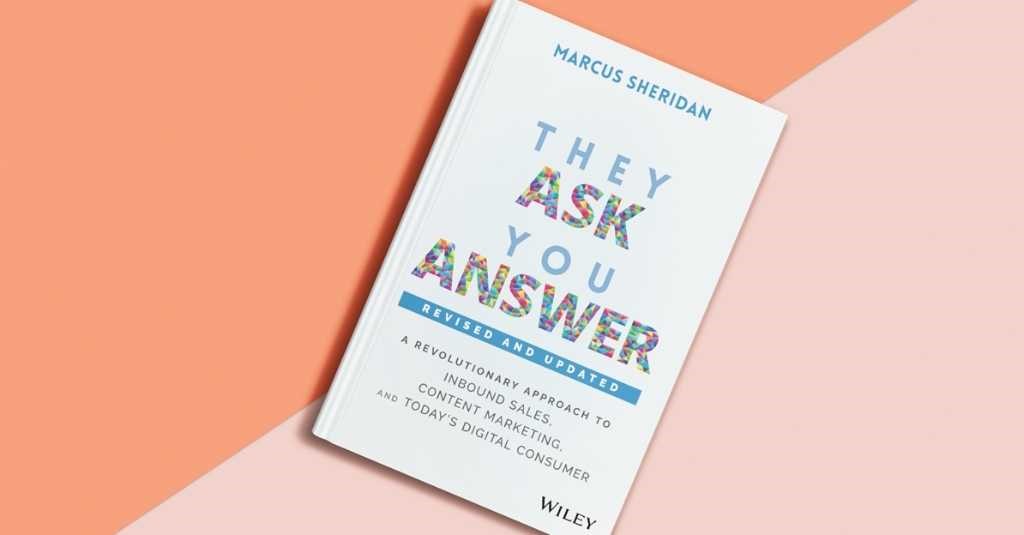If you had to focus on one thing in sales and marketing – the one thing which would make all the difference – what would that one thing be?
In the digital world that we’ve found ourselves in, there seems to be an abundance of bells and whistles that distract us in all sorts of directions.
However, when it comes to business – to growing and attracting profit – chasing shiny objects causes a lack of focus and direction, the result of which does not add any real value to the business. Instead, we want to be clear, directed and focused in business and marketing.
When we asked ourselves the ‘one thing focus’ question years ago, the answer we uncovered was ‘They Ask You Answer’.
What Is ‘They Ask You Answer’?
They Ask You Answer (aka TAYA) is a practical framework and sales and marketing philosophy that assumes one simple truth: if your prospect or customer asks a question, you answer, and in doing so, you will become the most trusted voice in your space and will gain more business than you ever have before.
This sounds like such a simple concept on the surface, but it stretches wider and further than you could possibly imagine. Let’s break it down.
In this article, we’re going to cover:
- The Changing Buyer
- The Importance of Trust In This Process
- Deeper Dive Into They Ask You Answer
- How To Close a Deal Tomorrow Using They Ask You Answer With Assignment Selling
- So, what happens if my prospect doesn’t do the assignment?
- The Big 5: How To Exponentially Generate More Revenue Using These Content Hacks
- The Impact of TAYA On Sales Teams
- Is TAYA right for me?
- Setting Up TAYA In Your Team v.s. Outsourcing
The Changing Buyer
Did you know that on average, today’s buyer has already made 80% of the buying decision BEFORE the first sales call?
With the internet being the predominant point of research for most buyers, there is less of a reliance on the sales or customer service people of a business. As such, today’s buyer has generally already decided on exactly what they want before they even speak to a salesperson, because they’ve done all of their research online already.
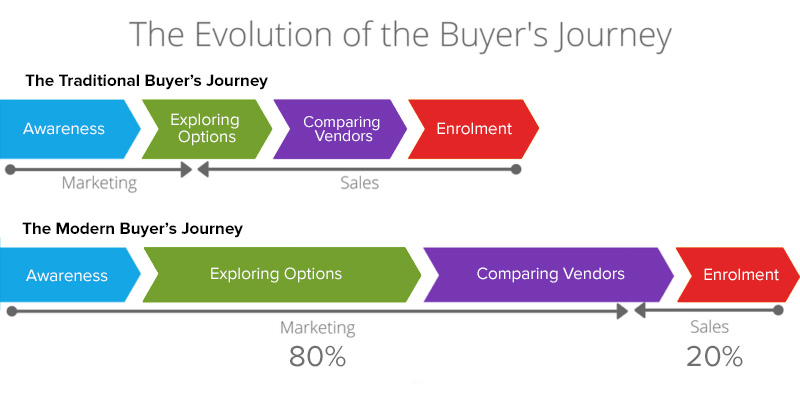
This number has been increasing over time, and we predict that it will continue to increase as the growing trend towards digital continues. But, why is this significant and how does it relate to TAYA?
If 80% of the buying decision happens before sales even gets a chance to have an impact on the decision, then there must be another department which has an even GREATER impact on the buying decision than sales. The question then becomes, which department is this?
You guessed it – marketing. This is the single department which is responsible for having the most impact on the buying decision, in every industry, for every product and service, and in every single instance.
Often, we find that the consensus and perception around marketing is that it is an expense for the business. However, this could not be further from the truth. When something impacts the buying decision to a large degree for your business it becomes an investment, not an expense, because, simply through it’s influence on the buying decision, it is by nature a driver of revenue.
Before we can even adopt the concept of TAYA, we must adopt the mindset of marketing as an investment and must recognise its significant impact on the bottom line. In doing so, we can begin to view marketing as a part of sales – and it is this, which can INSTANTLY change the game for any business. In other words, when we think about sales, we must think about how sales can become a part of content creation, so that it can become integrated with marketing.
In short, sales must inject itself into marketing and marketing needs to be accountable to revenue growth.
The Importance of Trust In This Process
People buy because they want to receive something from you, and the emotion which guides this exchange and allows it to flow is trust. In order to receive A in exchange for B, I must trust that you will fulfil your promise on giving me A when I give you B. This principle of truth is eternal and will always be integrated in sales, marketing, and business, not to mention our personal lives.
We should therefore be asking ourselves in every instance where our brand interacts with our prospect, ‘If we do this, will this lead to increasing trust with our customer?’
When it comes to TAYA, we want to keep this concept fresh in our mind and regularly ask this question so that we can ensure we are building trust between our business, and our future customers. This is the underpinning of TAYA – but how exactly do we go about building this trust?
Deeper Dive Into They Ask You Answer (TAYA)
The framework of TAYA essentially follows this thought process: we want to uncover customer prospect’s worries, needs, issues, fears, barriers, uncertainties, pain points, hopes, and dreams, and respond to these buyer motivators with honest, thoughtful, and complete answers, and to build a culture around this in our team. This method will massively and directly impact sales.
In order to make this method work, we must do the following:
- Conduct research to better understand customer questions and concerns.
- Speak directly to our sales team to understand customer questions and concerns.
- Create blog articles and videos around each of these questions/desires.
Conducting Research
You can conduct research in one of two ways. First, you can conduct research by directly speaking with customers and asking them questions in a mock interview style in order to uncover their questions and concerns. However, this method can be quite difficult to organise. So, how can you conduct research in an effective, budget friendly way, but still get significant results?
Although we highly recommend speaking to customers first hand we understand this may not always be pragmatic. What you should be doing in any regard is using online tools for market research. This involves utilising a mix of basic keyword research and forum searching.
First, you want to use a keyword tool (like the free Google Ads Keyword Planner or a paid tool like SEM Rush, which is what we use for our clients) to find the most searched terms related to your product or service. Once you’ve discovered these search terms, you want to head over to Quora and Reddit, and search for these terms on the platforms. What you will discover is a rich plethora of questions and concerns from you target market, which reveals all of their buying motivators. And with this information, you have everything you need to move onto the next step.
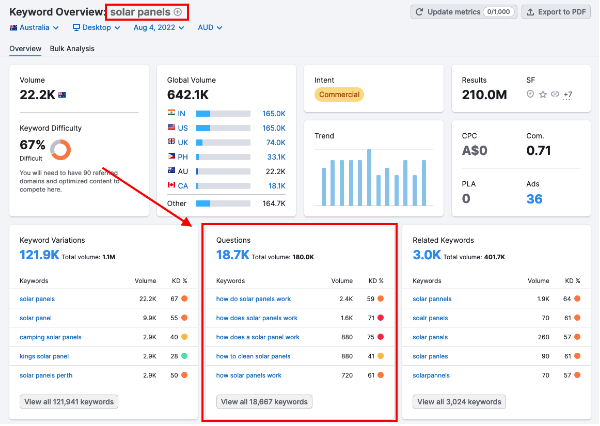
Of course, there will be queries which may be unrelated, but among the haystack of unimportant, you will discover shiny golden nuggets which will change everything.
But it gets better. Each of these customer questions becomes a content opportunity for your business, which is actually a revenue growth opportunity, since these content pieces relate directly to their buyer motivators and thus directly impact the sale.
Speaking To Your Sales Team
Another way you can discover your customer queries and concerns is through your sales team. Your sales team spends EVERY SINGLE DAY with prospects. Who better to talk to about the storm than those who live in the thick of the storm every single day?
Often sales doesn’t respect the content your marketing team has created because they weren’t part of the ideation process.
Talking to your sales team is great and all, but what exactly should you talk about? The TAYA framework has a recommended method of running these types of meetings with sales teams that we follow at RedPandas. The most efficient way to run these meetings is to ask the following questions to your sales team:
- What questions do you get asked by your prospect that immediately indicate that they are not close to ready to make a decision?
- What do your clients and buyers push back on the most?
- What are your buyers biggest doubts or worries (with respect to the product, the process, and the company)?
- What do your buyers have to convince the key decision makers of?
- Are there any other questions your prospect asks you during the sales process?
With these questions, on top of what you have discovered from your research, you will end up with a list of content ideas ready to go that directly relate to customer questions and concerns. This leads us to our next point – creating the blog articles.
The best way to get content ideas out of sales isn’t to ask them ‘what articles or videos should we create?’ – it’s to tease ideas out with a specific line of questioning as referenced above.
Creating Blog Articles
Once you have the customer questions ready, it’s time to actually create the blog articles. Yes. Good old blog articles. We’re not knocking social media and TikTok (our CEO is a TikTok addict himself), but if you don’t have content that answers most of your buyer’s questions on your own website, stop chasing shiny objects!
There are a million ways to write blogs but what is the most effective, revenue-led way?
Short of writing a 1000 word piece on how to write blog articles and best practices, here are some basic things to keep in mind. You’ll want to make sure:
- You have considered who you’re creating the content for (who will be reading this), what this person actually wants to get out of reading the content, why they should listen to you, and how you are going to help.
- You will want to make sure you have built a compelling introduction. One simple process you can follow for this is to ensure that your introduction clearly indicates the problem your buyer has, the expertise which you and your company has in solving the problem, and a promise with what they’re going to walk away with after reading the content.
- Ensure your blog article is as accurate as possible. This sounds simple, but in order to built trust and really lean into this method, you will want to focus on being trustworthy and accurate.
One of the most important factors that we’ve seen via hundreds of TAYA examples is businesses that adopt TAYA properly write three articles per week.
There’s something about this rule of three articles that Google’s algorithm loves and rewards you with high rankings. Adopting this practice is better than hiring any SEO agency period.
How To Close a Deal Tomorrow Using They Ask You Answer With Assignment Selling
Now that you understand the basic approach that you should be taking with They Ask You Answer, you can use this framework to close a deal…literally tomorrow!
How the heck can we do this, you ask?!
Hehehe, well, we can do this by utilising a sneakily powerful approach called Assignment Selling.
If someone reads 30 or more pages of your website, they will convert 80% of the time. In comparison, those who read less than 30 pages of your website will convert only 20% of the time. In other words, the number of interactions a prospect has with your brand directly impacts the sale.
This makes sense, since a larger number of interactions with your brand, especially interactions which answer questions and concerns, builds trust, and trust is the underlying emotion that guides the buying decision. This finding is extremely important, because it helps us integrate TAYA into our sales tactics which impacts on our bottom line drastically.
The typical sales process involves following up. After the discovery call, we follow up. After the proposal has been sent, we follow up. But, what if we could transform these interactions from mundane and somewhat ineffective follow ups into trust building, machine converting words? This is where Assignment Selling comes in.
Assignment Selling is the process of integrating content into our sales process to shorten the sales cycle and increase the close rate. We do this by giving the prospect an assignment at each follow up, where we provide them with an article or piece of content we have created using the TAYA framework. Let’s look at an example of an email follow up prior to the initial discovery call.
“Hi Mike,
I’m looking forward to connecting with you. To be sure we use our time effectively, here are a few resources that will help you become more familiar with our agency and our approach so you can determine if we’re the right fit for your organisation.
Please take the time to review these before our call.
<blog article link>
Here is a link to my calendar. Please book a time that is convenient for you”.
This approach allows you to be seen as the educator. Something magical happens when your prospect sees you as a trusted advisor as opposed to a salesperson – they see you as caring. And when they see you as caring, they trust you. And you’ve earned that trust, because you’re sharing with them pieces of content which are actually valuable – content which will answer their questions and concerns, and help them make the best buying decision. And hey, if they realise that you’re not the best fit for what they’re looking for, then that’s a good thing, because you helped them reach that conclusion. Who do you think they’re going to go to when they need to make their next buying decision?
This approach can literally add revenue to your bottom line tomorrow. So, what do we recommend?
Do some research. Write a buyer focused TAYA blog article. Use that blog article tomorrow in your sales process. Watch what happens.
If you’re looking to implement this for your business and need a hand, you can book a time with one of our experts here.
So, what happens if my prospect doesn’t do the assignment?
The assignment you give your prospect demonstrates how committed they are to becoming more educated on the topic they’re making a buying decision on.
An uncommitted buyer will not do the assignments you give them. If they STILL want to jump on the next call with you, then that means they’re going to ask you the questions that would have been resolved if they did the assignment. And if this is the case, they’re probably going to shop based on price, which might mean they are not a right fit for you anyway.
By using TAYA to become the most trusted voice in your space, you prevent the commoditisation of your product or service and you steer away those who are only interested in shopping based on price.
In this way, we learn who isn’t a good fit, which is very important, because when you know who isn’t a good fit for your business, you can focus more on who is the good fit, and this changes everything.
The Big 5: How To Exponentially Generate More Revenue Using These Content Hacks
Amidst all of the questions and concerns that your customers have, which you can address by utilising the TAYA framework, there are 5 question categories which we’ve discovered have the biggest impact on the buying decision.
Focus on just these five categories when developing content, are you’ll skyrocket your company’s revenue. So, what are The Big 5?
Cost and Price
How much do you talk about cost and price on your website? If you’re not an ecommerce store, my guess is not a lot, right? This is not great, because buyers search for price, and when you don’t show it they feel like you’re hiding something because you know something but aren’t sharing it, and this hinders trust.
Really. Think about it. How do you feel when you’re doing your own research and can’t find the price online? I’m guessing the f-word of the internet comes to mind: Frustrated.
Generally, there are three reasons company’s won’t offer price on their website:
- “Every job is customised” or “It depends”. This may be true, but if this is the case, then share this with your customers. Talk about the factors that impact price and give them a range, you don’t have to upload your entire price list without context. Give them the full spill on all the different customisations and how it all works. And, at the end, give them a price range, so that they know what to expect.
- “My competition will find out”. Let me ask you a question – how much is your competitor charging (approximately) for the same service you’re offering? Chances are, you have an answer to that question. Just like you already know, your competitors already know how much you charge. So, what’s the big deal? Besides, your competitors do not pay your bills.
- “We’re going to scare our customers away because we’re more expensive”. What actually scares customers away is when we leave them in a state of ignorance because we aren’t willing to talk about these things.
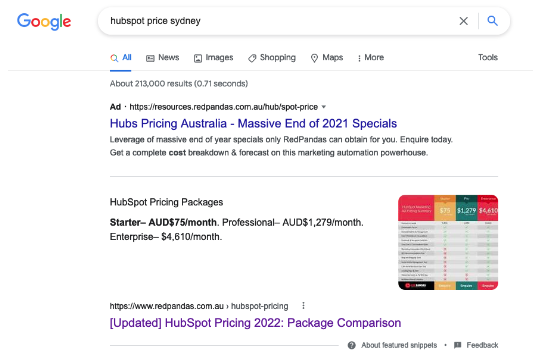
Clearly, we should absolutely be talking about price. Then the question remains, how do we even talk about it?
Well, we want to break it down on every level, and do comparisons as well. You can say that the price depends, if you explain it, and this is better than not saying anything at all and ignoring the topic. When you actually focus on educating the market on price, they then become happy to purchase at a higher price.
Problems
Think about the questions you hope your customers don’t ask you, the ones that keep you up at night. Now, ask yourself, are you willing to answer these questions?
You might see these as negative questions, but really, they are opportunities, only when you address them. Because when we think about it, the questions aren’t going away just because you’re ignoring them. By being the voice of trust in the industry that addresses them you’re creating trust and opportunities.

The greatest way in life to resolve a concern is to address it before it becomes a concern. So you can either wait for your competitors to address them, or you can lead the conversation in your space.
Versus and Comparison
We always get questions around comparisons. For example, ‘Why should I use Inbound Marketing instead of Outbound?’, ‘Instagram vs TikTok’, ‘HubSpot vs Salesforce’ – the list goes on and on.
As aspiring voices of trust in the industry, we should answer these questions, however, we want to ensure we aren’t biased, regardless of our stake in the game. We need to present both sides of the coin.
Brands don’t often speak like this, but when they do, they make a big impact. Think about all of the comparison questions your customers have asked you over the years and ask those questions.
Reviews and The Best
The final two question categories are reviews and best base questions. Consumers love to see reviews and best based questions (i.e. “Best Marketing Agency To Use In Australia”) because they feel like if they can compare and stack value in this way, then they can make the right decision.
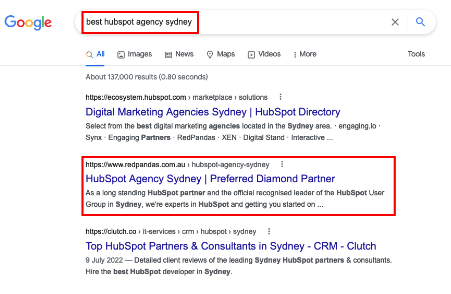
Important note: If you make a best of list for your business, you should absolutely NOT include your own business on the list. Resist the temptation. Doing this will only result in a loss of credibility. You might feel uncomfortable but think about it. Where are they reading this information? On your website!
Creating a ‘best of’ piece benefits you greatly, because it transforms you into the trusted voice in the space and importantly, it allows you to rank for your competitor keywords which results in you sharing a piece of your competitor’s pie.
You may still have reservations but there are key considerations we recommend when crafting ‘best’ articles that I can share in future articles so be sure to subscribe here.
So, these big five question categories: Cost and Price, Problems, Comparisons, Reviews, and The Best, are the categories you would want to produce content across as soon as possible, because these are the ones that will make THE BIGGEST impact on sales.
The Impact of TAYA On Sales Teams
There are seven major benefits of They Ask You Answer on sales teams.
- Producing content forces us to understand the buyers and the way they think. When we start listening more intently, we get to know and understand the customer more than ever before.
- Producing content is magical when it comes to sales messaging. All of your sales team end up becoming subject matter experts which massively impacts close rates.
- Company content acts as a training guide for new employees.
- Using content in the sales process to give assignments to your prospects (aka Assignment Selling) dramatically shortens the sales cycle and increases close rates, leading to more revenue more quickly. It also positions your business as trusted advisors.
- Sales teams can learn, through website analytics, what prospects and customers truly care about before they enter the sales funnel. Imagine knowing exactly what articles your prospect has read prior to jumping on the call. This changes the way we do sales presentations and calls because EVERYTHING becomes data backed. This is what happens when marketing becomes integrated with sales.
- With content, a relationship of trust can be built with a salesperson and company before the first sales meeting ever happens. A prospect who has read 10 articles before entering a sales meeting is going to perceive the company far differently to a prospect who has never read any piece of content from the company.
- Great content means more trust, more trust means shorter sales cycles, shorter sales cycles means happier sales teams.
If you can successfully implement TAYA within your business, you won’t only be positively impacting your bottom line, but you’ll be positively impacting the happiness of your sales team. You’ll become the most trusted voice in your space. You will wildly transform your entire company.
Is TAYA right for me?
TAYA can have a positive impact on ANY business, in any industry, both B2B and B2C. As such, it’s no doubt that you should implement TAYA in your business. The question is, should you implement TAYA right now?
If you’ve read this far and digested the above, you’ll be a good judge of whether it’s right for you.
What’s clear for any business of any size looking to implement TAYA is they usually meet three criteria:
- Be willing to answer buyer questions online transparently
- Have senior leadership buy-in
- They’re in a state of frustration after working with agencies before that didn’t produce expected results.
How to Implement They Ask, You Answer
As a certified They Ask You Answer partner and legally owned by IMPACT, the agency that developed They Ask You Answer, we want everyone to have success with the framework.
In our experience there are two ways you can implement TAYA:
- Buy the They Ask, You Answer book and implement it yourself
- Engage a TAYA certified business to train and coach your team to never need an agency again
The first step for anyone interesting in TAYA is to buy the book and understand the framework. The inevitable next question becomes: can we do this ourselves or do we need external help?
In our experience, the practical learning curve in adopting TAYA effectively is what drives businesses to work with certified TAYA businesses who have done and seen it all before.
The learning curve to figure out how to TAYA properly can take years because it includes mastering things like:
- Getting alignment, commitment and respect from both sides of sales and marketing
- Hiring and onboarding a Content Manager (and eventually your in-house videographer)
- Writing buyer-led TAYA content that converts
- Creating and scaling the output of 3 articles per week
- Distribution tactics of your content like email newsletters
- Creating reports that show content marketing ROI
- Using automation systems like HubSpot to leverage content
- Creating a learning centre on your website
- Training sales to do assignment selling
- And much more…
The core thing to keep in mind when considering a certified TAYA partner is that you and your team will be doing the work. This is not about outsourcing TAYA, it’s about shortening the learning curve it takes to master TAYA so your team is empowered and self-sufficient to do TAYA internally.
If you are looking to implement TAYA yourself, we highly recommend as least hiring a Content Manager to manage the content process and write 3 articles per week.
Implementing TAYA vs Outsourcing Your Marketing
At RedPandas we operate both as a Done For You (traditional digital marketing services) and Done By You agency (where we train businesses over 12-18 months to implement TAYA in house). Both modes yield results. What’s evident though, you’ll always achieve greater results when you take your sales and marketing in-house.
We could write an entire article about the pros and cons of implementing TAYA within your team versus outsourcing its implementation.
However, the overarching idea is this: why would you outsource the soul and heart of your business?
While outsourcing may be more cost effective in the short term, it doesn’t allow us to have a tone, style and personality that exactly matches our company. You see, when we answer the prospect’s question or concern, we want our company to answer that question or concern. And who better than to answer this than our own people?
So, what’s next?
You’re probably sitting there thinking, “Ok ok, I get it, I get it! TAYA is an important framework and I should absolutely implement it. But where the heck do I even start?”
If you plan on implementing it yourself, a practical piece of advice is to brainstorm, either by yourself or with your sales team, all of your customer concerns and questions. Once you have a list of questions, pick one question, and write one article that answers that question. And then, use this same article in the sales process, and see what happens! Rinse and repeat, and you’re off to a good start.
If you or your team require training on TAYA, we offer business coaching & training programs to help your team get set up with implementing They Ask You Answer for your business. If this is you, book a call with one of our experts here.


